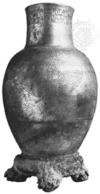- Lagash
-
/lay"gash/, n.an ancient Sumerian city between the Tigris and Euphrates rivers, at the modern village of Telloh in SE Iraq: a palace, statuary, and inscribed clay tablets unearthed here.
* * *
It was located midway between the Tigris and Euphrates rivers in Babylonia, now in southeastern Iraq. Excavations have uncovered palace and temple ruins as well as cuneiform texts that provide information about Sumer in the 3rd millennium BC. Founded in the Ubaid period (с 5200–с 3500 BC), it came under the control of Sargon of Akkad. It later prospered under Gudea, a governor nominally subject to the Guti. It was occupied as late as the Parthian era (247 BC–AD 224). Engraved silver vase of King Entemena, from Lagash, Early Dynastic Period; in the Louvre, ParisArchives Photographiques
Engraved silver vase of King Entemena, from Lagash, Early Dynastic Period; in the Louvre, ParisArchives Photographiques* * *
▪ ancient city, Iraqone of the most important capital cities in ancient Sumer, located midway between the Tigris and Euphrates rivers in southeastern Iraq. The ancient name of the mound of Telloh was actually Girsu, while Lagash originally denoted a site southeast of Girsu, later becoming the name of the whole district and also of Girsu itself. The French excavated at Telloh between 1877 and 1933 and uncovered at least 50,000 cuneiform texts that have proved one of the major sources for knowledge of Sumer in the 3rd millennium BC. Dedicatory inscriptions on stone and on bricks also have provided invaluable evidence for assessing the chronological development of Sumerian art.The city was founded in the prehistoric Ubaid Period (c. 5200–c. 3500 BC) and was still occupied as late as the Parthian era (247 BC–AD 224). In the Early Dynastic Period the rulers of Lagash called themselves “king” (lugal), though the city itself never was included within the official Sumerian canon of kingship. Among the most famous Lagash monuments of that period is the Stele of the Vultures, erected to celebrate the victory of King Eannatum over the neighbouring state of Umma. Another is the engraved silver vase of King Entemena, a successor of Eannatum. Control of Lagash finally fell to Sargon of Akkad (reigned c. 2334–2279 BC), but about 150 years later Lagash enjoyed a revival. It prospered most brilliantly under Gudea, who was probably a governor rather than an independent king and was nominally subject to the Guti, a warlike people who controlled much of Babylonia from about 2230 to about 2130.Lagash was endowed with many temples, including the Eninnu, “House of the Fifty,” a seat of the high god Enlil. Architecturally the most remarkable structure was a weir and regulator, once doubtless possessing sluice gates, which conserved the area's water supply in reservoirs.* * *
Universalium. 2010.
